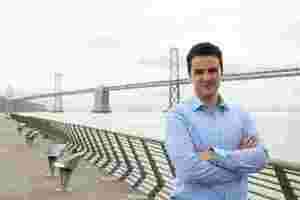Onfido’s CEO on how to play the fundraising game — stage by stage
I first spoke to Husayn Kassai, CEO and co-founder at Onfido, in the Summer of 2016, four years after it was first set up. At the time, the startup , co-founded by three young Oxford University graduates , had raised an undisclosed sum from Salesforce Ventures, Talis Capital, and several angels .

Fast forward four years and Onfido — which helps businesses verify peoples ’ identities using a photo -based identity document , a selfie , and artificial intelligence algorithms — has just closed an impressive $100 million Series D . But how did Kassai and his team make this happen?
As I join our online meeting , I’m well aware of the fact that Onfido, which has raised $200 million to date, is at a completely different stage of its business journey than it was all those years ago — and so I make it my mission to find out what propelled its growth .


Fundraising: So very different at every level
Unsurprisingly, the first thing on my mind is fundraising, which Kassai admits has gotten easier with time, but notes there are certain things entrepreneurs need to keep in mind.
“If you’re early stage, you need to find and talk only to decision-makers and partners at firms and spend time with them in person,” he advises, noting how partners often have to then sell the potential deal to their own investment committee.
“People think you can go to an associate, give them all the data , and that then somehow that makes it up the chain . It’s the opposite.”
Anyone’s who’s raised venture capital before will know that fundraising at the later stages — Series B and beyond — is an entirely different experience .
Later-stage companies such as Onfido may have the metrics to justify their market validity but it’s important founders don’t get complacent.
“Look at the partner in detail and see what drives them,” Kassai says.
It’s not unusual for companies at this stage to be able to choose who they want to take investment from in exchange for equity — after all, being picky comes with the territory. And if it doesn’t, you’re probably doing something wrong.
Founders need to consider whether they want the external validation — and media headlines — that comes with raising from an investment giant, or if they prefer to go after someone who’s just looking to back two or three companies and will put their heart and soul into their portfolio.
Ultimately, there’s no right or wrong. It just depends on what makes sense for the business.
The first hire
Kassai thinks back to the early days, when Onfido’s team consisted of just him, his co-founders Eamon Jubbawy and Ruhul Amin; and the company’s first hire: An engineer called Jeff.
Fresh out of university, and despite dabbling in entrepreneurship after becoming involved in a student club, the trio had little experience in the real world — nor had they ever been responsible for hiring and paying someone.
Aware that this first hire was crucial for the future culture and success of the business, and acknowledging that early-stage startups often attract talent by selling their mission and vision, Kassai and his co-founders made the collective decision to pay themselves less than Jeff, who was also given equity in the business.
“Today, Jeff’s shares are worth more than a million and he’s very happy,” Kassai says.
It’s fair to say that Onfido is doing well. In February, the company announced a year-over-year growth of 130% — although Kassai wouldn’t tell me whether the business is yet profitable.
Kassai is also in talks with several governments to offer Onfido’s identity solution as a way of helping them monitor people who have recovered from COVID-19.
Today, the company is nearing 400 employees and although it remains London-based, it has offices in San Francisco, New York, Lisbon, Delhi, and Singapore.
People: First and foremost
This growth, however, didn’t happen overnight and Kassai is adamant that people have played a huge part in Onfido’s journey.
“There are a few things I wholeheartedly believe in and one is that most people, if given the right support and trusting environment, can do a lot more than they actually expect,” he says.
“I also believe that it’s human nature to want to achieve something without being forced to do so. So, in a way, this trickles throughout all teams. So you want, and need, your team to succeed,” says Kassai, adding “that value comes from people first and foremost.”
“As long as you have the right people, you’ll come up with the right processes, even when the founders are taken out of the picture.”
Growing a business isn’t necessarily a linear process, there are many tribes and tribulations, many decisions — some correct, others less so — to be made, and many lessons to be learned.
“I’m sure I would have done many things differently. You have to look at the glass half full. You learn every day,” Kassai concludes.
Hindsight is indeed a powerful thing, and while it’s important for founders not to lose sight of the past, it’s crucial they remain focused on the present and the future.
This people-centric approach has certainly paid off for Onfido. If you’re just starting out, obsess about your first hires, and who knows, your very own Jeff may well be a millionaire in years to come.
Poll: Employees would rather make less money than go back to an office
For many people, one of the few good things about this pandemic has been the ability to work from home. The past year has shown both employees and employers that many jobs can be done effectively from home.

In fact, the desire to keep work from home has been so strong that it appears a significant majority of people would rather turn down a $30,000 salary increase than lose the ability to work from home.
A poll posted on Blind , an anonymous forum for employees , asks:
It’s far from a scientific survey, but with over 3,000 votes so far, 64.3% say they would rather keep working from home, while 35.7% would opt for the extra cash.
A representative for Blind further elaborated with some specifics, such as that 71% of Airbnb, 81% of Lyft, 89% of Twitter, and 100% of Zillow employees would rather keep working from home.
A simple poll like this obviously misses some nuances, such as how much money the employees are making in the first place, or how often employees would have to go back to work. Because the question asks about switching jobs rather than, say, getting a raise at your current job, the results may be further skewed.
Still, this is not the only poll to suggest employees largely want more ability to work from home.
A survey run by the Harvard Business School Online and research firm City Square Associates polled nearly 1,500 professionals between March 2020 and March 2021 and found that “81% either don’t want to go back to the office or would prefer a hybrid schedule going forward.”
More specifically, 61 percent would like to be able to work 2-3 days from home, while 27% hoped to work remotely full time.
Only 18% of respondents wanted to go back to the office full-time. Curiously, parents with kids at home and married people were more likely to want to go back to work full time than singles.
As someone who’s been working from home for years before the pandemic, it’s hard to imagine going back to the office. Time is money, and the time wasted commuting is something that’s hard to put a price tag on.
How the coronavirus crisis is changing the insurance industry
The COVID-19 pandemic, an unprecedented event in modern history, continues to leave its mark on societies and economies around the world. We have learned many lessons so far, the most poignant one being that we weren’t prepared for this.

The impact on the global economy has been devastating. The International Monetary Fund (IMF) says the global economy will shrink by 3% , the worst decline since the Great Depression of the 1930s. Many advanced economies, including the US, UK, Canada, France, and Germany are expected to enter a recession this year.
The Dow and FTSE have suffered their worst quarterly drop since 1987. Oil prices have crashed as lockdowns have brought commuting and traveling to a standstill. In the U.S., the price of West Texas Intermediate (WTI) dropped below zero for the first time in history.
Amid the outbreak, businesses are trying to stay afloat, scaling down operations or shutting down altogether. The insurance industry, which supports businesses through crises and disasters, is one of the sectors at the forefront during this challenging time. And like everyone else, insurance companies are drawing lessons from the pandemic and learning to adapt.
Insuring against a pandemic is hard but not impossible
Pandemics like the coronavirus outbreak are inherently different from other natural disasters. While catastrophes such as hurricanes, earthquakes, and floods hit a specific region, pandemics have no geographical bounds. The timeframe of pandemics of highly contagious diseases such as COVID-19 is virtually unpredictable.
All this makes it harder for insurers to assess and accurately model the risks.
Like any other industry, the insurance sector has finite resources at its disposal. If a disaster hits everywhere simultaneously and for an indefinite period of time, it inevitably puts a lot of strain on insurers. According to the Association of British Insurers , insurance firms have been managing an unprecedented level of activity in response to COVID-19 with some companies reporting a 200% rise in call volumes into their call centers. At the same time, a pandemic inevitably leads to operational challenges for all.
Many insurance underwriters do provide pandemic coverage, and some companies have had the foresight to buy a specific pandemic insurance policy. One example is the Wimbledon tennis tournament , which has paid $31.7 million for pandemic insurance premiums since the SARS outbreak in 2003. The company will reportedly receive $142 million from its insurers for this year’s canceled tournament.
But, generally speaking, the uptake of pandemic insurance has been very low, partly because customers viewed the premiums as expensive and the risk distant. In general, businesses purchase interruption insurance policies that exclude pandemic coverage as standard and only cover physical damage on-premises.
With so few businesses having policies that provide coverage against the coronavirus pandemic, insurers have not been able to build up reserves to pay claims in this area.
But given the current circumstances, insurance companies have joined in the collective response to help support the economy. The estimated 2020 underwriting losses covered by the industry as a result of COVID-19 are approximately $107 billion. The industry is also expected to be dealing with a massive $96 billion fall in portfolio investments.
“It is a human and economic catastrophe that presents complex short, medium and long-term challenges requiring government and industry to join efforts to support all of those businesses and people who have been hardest hit,” John Neal, Lloyd’s CEO, said in Lloyd’s latest statement.
During the pandemic, Lloyd’s has been paying out roughly £500 million in claims every week. Lloyd’s recently announced it expects to pay up to£3.75 billion (approx. $4.3 billion) to global customers total as the lockdown continues and the market responds to COVID-19 claims across a wide range of losses, from event cancellation to D&O.
“Our immediate focus is supporting our customers in their time of need through the crisis, including ensuring the prompt payment of all valid claims,” Neal said.
Lloyd’s also announced its intention to donate £15m to charity partners leading the response to COVID-19, focusing on initiatives around healthcare, innovation, and wellbeing in the UK and other major markets including the US.
Looking toward the future
The COVID-19 pandemic has exposed the vulnerability of businesses. With viral outbreaks becoming more frequent , the market for pandemic insurance is likely to grow.
But given the unprecedented scale of impact that the COVID-19 pandemic has caused, it’s not clear whether pandemics can or should be covered through an insurance model. Many experts are stressing that state involvement in such situations is inevitable.
What is clear, however, is that businesses can do much to protect their operations against the outbreak of viral diseases. Organizations are fast adopting technologies that can enable them to continue their operations while remaining compliant with social distancing rules. Many companies are transitioning to cloud servers and applications that allow their employees to work from home instead of congregating in offices. Video conferencing and online collaboration apps are replacing in-person meetings. Online shopping is replacing physical retail. Social media live streams are becoming an alternative for concert and conference venues.
The experience we gain from adapting to the COVID-19 lockdown will play a key role in shaping pandemic insurance policies. In the future, insurance brokers will be able to coach businesses in adopting the right measures to continue operating in times of pandemic quarantines and reduce their risks.
Lloyd’s is funding £15m in seed capital to explore the medium- and long-term solutions that the industry could put in place. “We are repurposing some existing initiatives to help fast-track the development of innovative new products and solutions to help with economic recovery and resilience,” Neal said.
The Product Innovation Facility, Lloyd’s initiative to innovate and experiment with new ideas in insurance policies, will allocate its resources to pandemic response. The company will also focus the next cohort of Lloyd’s Lab, its insurtech startup incubator, on leveraging new technologies to help deal with widespread business interruptions. Lloyd’s is also working with governments and regulators in different jurisdictions to consider long-term structures that could be put in place to build resilience against global economic shocks.
“We will focus on how we can support the recovery and future resilience of our customers and more broadly the global economy, in the face of further waves of COVID-19 in the medium term, and future global catastrophic events in the long term,” Neal said.